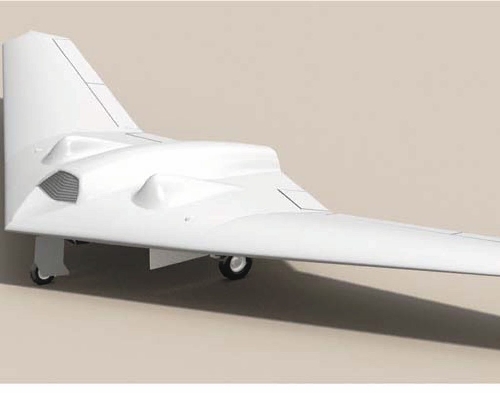Drones aimed at fighting future wars

Imagine swarms of drone aircraft fighting the wars of the future.
One big remotely piloted “bird” could control an array of stealthy planes with bombs and missiles to “knock the door down” for manned fighter jets high over enemy territory via satellite links to a ground station in Nevada. Or South Dakota. Or anywhere.
The future of unmanned aerial vehicles, from those the size of a fist to those as big as the Beast of Kandahar, is unlimited for military applications as well as those in civilian aviation, said Maj. Gen. James O. Poss, assistant deputy chief of staff for Intelligence, Surveillance and Reconnaissance at Air Force Headquarters.
“Reasonable men can differ over whether the commercial application of this is going to be in the hundreds of billions with a ‘B,’ or a few trillions with a ‘T.’ But it’s going to be huge,” Poss said after a panel of military and defense industry experts discussed today’s challenges and tomorrow’s solutions during an international drone conference last week at Mandalay Bay.
The success of unmanned aerial vehicles in the global war on terrorism in the past 10 years is a “very, very small portion of what we’re going to see in the future as we learn how to handle these tough technical problems: The issues with privacy, the issues with safety, the issues with reliability, the issues with flying in controlled airspace,” Poss said.
“But once we do that, I think it’s amazing what we’ll be able to do with this technology.”
UAVs have changed the military.
“They’ve given us the ability to truly know a target beforehand. … It allows us to really make sure that we’re putting our weapons where we need to and we’re not causing undue civilian casualties. And it allows us to do that with a very minimal footprint of airmen actually in harms way.”
What is still a government secret but widely known in aviation circles is that the future is here because UAVs already have evolved to stealthy, jet spy planes such as Lockheed Martin’s RQ-170 Sentinel, a 65- to 90-foot flying wing.
It is known as the Beast of Kandahar because of grainy photos taken of it near Afghanistan’s Kandahar Airfield in 2009.
The Beast, thought to be operated by the 30th Reconnaissance Squadron at the Tonopah Test Range, made news again when one turned up in Iran in December, but Poss wouldn’t say much about the RQ-170 on Wednesday.
“That’s about it. We do have the RQ-170. It’s a low-observable aircraft, and that’s about it,” he said after a session at the Association for Unmanned Vehicle Systems International conference.
Sources familiar with the RQ-170’s development recall a smaller version of the flying wing in the late 1980s, dubbed DarkStar, or RQ-3, which indicates it is a platform that doesn’t carry weapons but is designed to make long flights for mid-altitude reconnaissance and intelligence gathering. It was developed at Edwards Air Force Base in California.
Speed and efficiency in delivering images for battlefield leaders and their staffs to assess have come a long way since Poss joined the Air Force and the workhorse was an RF-4 drone, a converted fighter jet with a film camera and side-looking radar.
“We were lucky to get that film processed within 12 hours and back to the Army,” Poss recalled. “What we were doing was giving them 1/100th of a second of what happened 12 hours ago.
“Now our Predators can get real-time video 30 frames per second from just about anywhere we want to on Earth within two seconds,” he said.
From ground stations thousands of miles from the battlefields of Afghanistan, pilots and sensor operators can control flight via satellite links and, in the case of the MQ-9 Reaper, remotely fire laser-guided missiles and drop bombs.
As Poss spoke about the prospects for UAVs last week , reports surfaced that U.S. drones had targeted moving vehicles in Yemen and killed 10 al-Qaida militants, including Abdullah Awad Al-Masri, who was in charge of a bomb-making lab. That is more evidence that drones play a vital role in U.S. security.
One panelist, Richard Kretzschmar, project manager for Army Unmanned Aerial Systems, said defense planners continue to think outside the box.
“What is the next war?” he asked. “The next fight might not be counterinsurgency. It might be high intensity.”
He said the Army is considering equipping every company in combat with an RQ-11 Raven, an unmanned aerial vehicles small enough to be carried in a backpack that can be launched by a soldier and controlled with a hand-held transmitter/receiver unit.
Retired Air Force Lt. Col. Harold F. Smith, a founding member of the Association for Unmanned Vehicle Systems International, said the roots of UAVs go back to the early 1970s.
That is when the prototypes, Maverick and HOBO, were tested after their need surfaced when U-2 pilot Gary Powers was shot down in 1960 on a CIA reconnaissance mission over the Soviet Union, and two years later during the Cuban missile crisis that put the United States on the brink of nuclear war.
“President Kennedy asked if there is a way we can get these photographs without putting a pilot in danger,” Smith said. “When Gary Powers got shot down, it marked the end of an era and the beginning of a new era.”
Contact reporter Keith Rogers at krogers@reviewjournal.com or 702-383-0308.